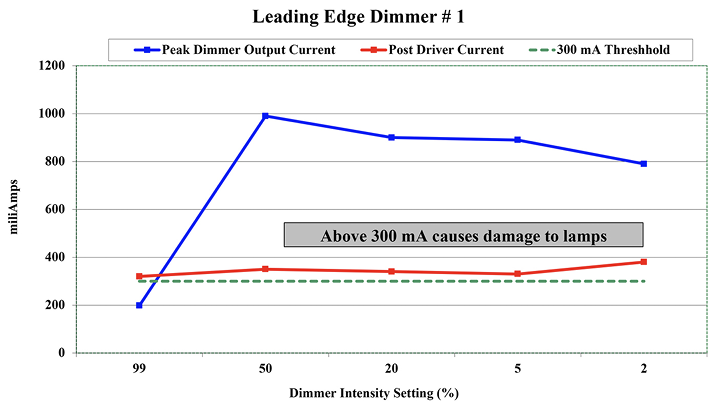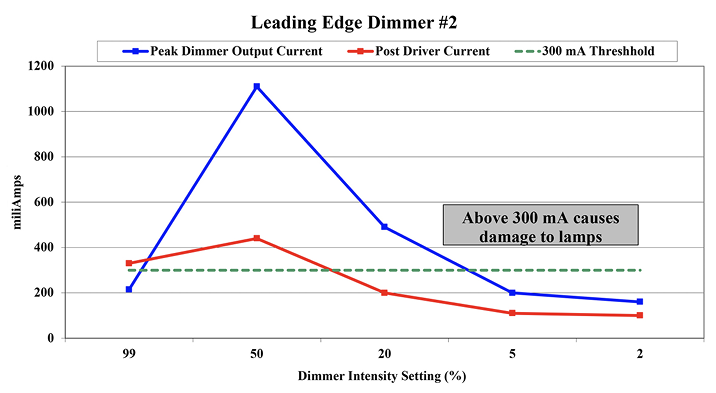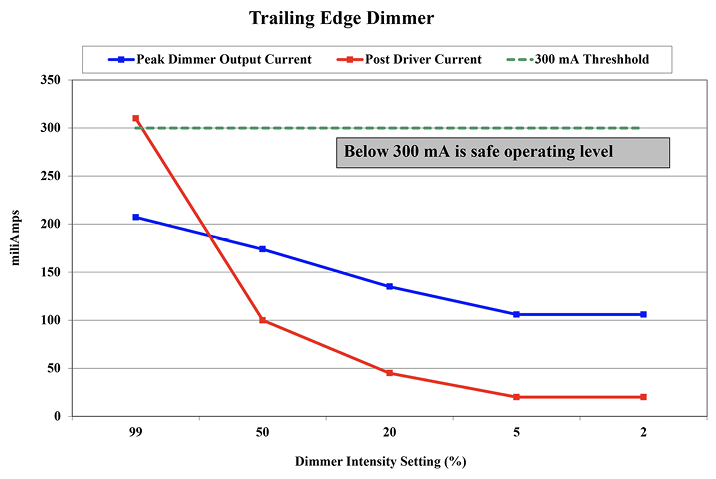Issues with Poultry House LED Lamps and Light Dimmers
LED lamps have changed the landscape for poultry growers in terms of energy savings related to poultry house lighting. No other lighting source (incandescent, compact fluorescent, cold cathode, high pressure sodium, etc.) comes close to the energy efficiency of LEDs. LEDs are roughly 80–85 percent more efficient than incandescent lamps. However, during the transition from incandescent to LEDs, there have been some hiccups (Tabler et al., 2019).
Starting late last fall, we began getting an increase in calls from growers concerning strange dimming issues and premature LED lamp failures. Trips to various poultry supply vendors and LED distributors revealed boxes and boxes of failed LED lamps (still under warranty) of various brands that had been returned by growers. Through conversations with these vendors and distributors, we determined that the premature lamp failure problem had been steadily increasing in recent months.
This is not normal nor expected, and it led us to dig a little deeper into what was going on. While we haven’t solved all the problems, we now better understand much of what is causing premature LED lamp failures and why some LEDs are losing brightness much more quickly than expected. Like many other complicated issues, it is not just one thing causing these problems. A part of the issue is the lamps, a part is the light dimmer, and a part is the compatibility between the lamps and the dimmer.
Incandescent and LED Lamps
Thomas Edison patented the incandescent light bulb (Figure 1; left) in 1879. It became one of the most world-changing inventions ever conceived. It produces light by forcing electrical current through a high-resistance tungsten filament. The result is about 80 percent heat and 20 percent light. Newer LED lamps (Figure 1; center, with globe removed, and right) produce light by switching current to a series of light-emitting diodes. LED lamps contain circuitry that includes drivers and light-emitting diode chips (Figure 2). Modern LED lamps are very efficient in comparison to Edison’s incandescent lamps. However, incandescent lamps are much easier to dim. In contrast, LED lamps are much more sophisticated and require special considerations for dimming and proper performance.


In less than a decade, the entire world (poultry industry included) has made a dramatic shift from incandescent lamps to dimmable LED lamps. Despite some growing pains along the way, the energy savings and long-life potential of LED technology made the frustration worth it. However, within the poultry industry during the past 8 to 10 months, widespread problems with rapid lumen depreciation, erratic dimming performance, and premature total lamp failure have been reported on LED lamps that were only 2 to 3 years old; in many cases, several years before the warranty had expired.
Investigations have determined that multiple brands of LED lamps are affected, but the issues are particularly severe with inexpensive, omni-directional LEDs intended for household use and not designed for the more demanding and harsh chicken house environment. However, the issues are also present in high-quality, heavy-duty, directional LEDs specifically designed to withstand commercial poultry industry demands. In today’s chicken house environment, the level of dimming and the wide variation in light levels required over the life of the flock demand that lamps and dimmers be compatible and designed to work well with each other.
While they are less expensive than high-grade agricultural LED lamps, household LED lamps do not hold up well in a poultry house environment and growers are often disappointed with their performance. In addition, LED lamp technology continues to improve and become more cost- and energy-efficient each year. As a result, dimmers and dimmer technologies must also be updated and improved to remain compatible with rapidly improving LED technology. Increasing evidence continues to point to the fact that dimmers with older dimming technology are not compatible with modern LED lamp technology. In other words, older style dimmers and modern LED lamps simply do not work well together, and this is causing many of the dimming and premature lamp failure issues.
No one realized 5 years ago that dimmers and LED lamps weren’t working well together, but we have since learned a great deal more about how dimmer operation may affect LED lamp life and performance. When the transition to LED lamps first began, we thought we had gotten a lucky break when our new LED lamps worked without changing the dimmer. However, as our pool of knowledge continues to increase in this area, we need to question the wisdom of not changing the dimmer. It’s somewhat complicated and requires some understanding of how electricity works, but here’s why we may need to consider changing light dimmers when using LED lamps.
How Dimmers Work
Alternating current (AC) has varying voltage polarity in an undulating sine wave that fluctuates from positive to negative voltage. In the U.S., this alternating cycle happens 60 times per second. This frequency is referred to as hertz. Common electrical supply in the U.S. is 60 hertz (the current “alternates” 120 times, or 60 cycles per second). Light dimming is possible because a dimmer chops off a percentage of the phase angle of the AC sine wave. The amount of the wave that is chopped off determines how bright or dim the lights are. If only a small amount of the wave is chopped off, the lights remain fairly bright. If a large amount of the wave is chopped off, the lights may be quite dim. There are two main dimming methods used to chop the sine wave, depending on whether the front edge or back edge of the sine wave is chopped:
- Leading-edge dimming utilizes a current that is turned off as the AC sine wave begins, just after it crosses zero into positive territory. It cuts the front edge of each wave’s half-cycle. Leading-edge dimming creates a rush of voltage every half-cycle, resulting in a rush of current to the light source. Also called forward-phase control dimming, leading-edge dimmers can produce spikes in current that can cause increased stress to electronic drivers (Liao, 2014). These current spikes are likely at the root of the issues we are seeing with LED lamps. Most LED chip manufacturers have indicated that exposure to current greater than 300 milliamperes will cause irreversible damage to the chips, which is typically observed in the field as erratic performance, excessive lumen depreciation, and premature lamp failure.
Leading-edge dimmer switches are simpler, less expensive, and much more common today than trailing-edge dimmers. They typically use a TRIAC (triode for alternating current) switch to control power. TRIAC dimmers have been used since around 1960 and were originally designed to dim incandescent and halogen lamps and wire-wound magnetic transformers. Many leading-edge dimmer switches have a relatively high minimum load, which often rules out their use with modest-load LED circuits. This explains why it is sometimes necessary to put an incandescent lamp at the end of the line in a chicken house to help the dimmer find enough load to properly do its job.
- Trailing-edge dimming (electronic dimming) utilizes a current that turns off as the AC sine wave ends, just before it crosses zero into negative territory. Trailing-edge dimmers are more sophisticated than leading-edge dimmers and provide smoother dimming control with less interference. They have been designed specifically for use with low-wattage LED lamps. Trailing-edge dimmers usually use a MOSFET (metal oxide semiconductor field effect transistor) or IGBT (insulated gate bipolar transistor) switch rather than a TRIAC switch and coil (ERP Power, 2016).
Trailing-edge dimmers have a much lower minimum load than leading-edge, making them much more suitable for powering modest-wattage LED lamps. Also called reverse-phase dimming, these dimmers avoid current spikes by switching the light phase circuit on just as the current changes direction and allowing the voltage to rise gradually before turning it off later in the half-cycle.
Unlike incandescent lamps, LED lamps have a built-in driver at the base. The driver converts AC power to direct current (DC) power and maintains a constant current supply to the LED lamp. This is in direct opposition to the phase-control dimming system used to dim the lights because the driver in the LED lamp tries to compensate for the chopped-out portions of the input voltage and maintain a constant current to the lamp. LED lamps rely on the driver circuits to provide constant DC current to the LED chips for proper performance. LED chips are current-sensitive devices and require good-quality, constant DC current (but not overcurrent spikes). For an LED lamp to work properly with a phase-control dimmer, the electronics of its driver must be compatible with the dimmer. Leading-edge dimmers work best with resistive loads (incandescent lamps). Trailing-edge dimmers work best with capacitive loads (LED drivers).
The incompatibility between LED drivers and TRIAC dimmers can cause multiple problems (Liao, 2014), including:
- pop-on, when the LED lamp suddenly turns completely on as the dimmer switch is gradually raised from the fully off position.
- dead travel, when changing the dimmer setting produces no visible change in light level.
- drop-out, when the lamp shuts off completely as it is being dimmed.
- ghosting, when light is still visible from the lamps even when the dimmer is fully off.
- audible noise from the lamp.
- flicker or strobing resulting from the current being applied by the driver to individual LEDs.
What to Do?
This is a tough question. As mentioned earlier, premature LED lamp failures are not the result of any one thing. It is critical to assess your unique situation and determine exactly where the problem lies. Again, inexpensive big box store LEDs should not be used in chicken houses. They are designed for households and not for the demanding workload that a poultry house environment requires. Also, if you switch to LED lamps from incandescent lamps or CFLs, you must have good-quality, keyless sockets and proper wiring. Inferior wiring and corroded sockets are not compatible with LED lamps. In addition, all lamps in a house should be of the same brand, wattage, and color (Kelvin rating). Different lamp manufacturers likely use different drivers that will act differently when dimmed, disrupting the light uniformity level throughout the house.
Perhaps the biggest concern is LED lamp incompatibility with the current poultry house dimmer. Like LED lamps, there are a variety of light dimmers used in poultry houses today. Unfortunately, information from numerous sources, including poultry industry executives, academia, lamp manufacturers, dimmer manufacturers, LED chip providers, and utility company power quality engineers, indicates that many common leading-edge poultry house light dimmers are producing large numbers of current spikes throughout the dimming curve. Independent dimmer testing on leading- and trailing-edge dimmers indicates that dimmer output current (blue line) and current to the actual LED chips (red line) for leading-edge dimmer #1 and leading-edge dimmer #2 produced current spikes in excess of 300 milliamperes throughout most, if not all, of the dimming range (green dotted line), while the trailing-edge dimmer produced current readings well below the 300 milliampere damage threshold (Figure 3).



Figure 3. Current outputs of leading-edge and trailing-edge poultry house light dimmers.
As a result of current spikes associated with leading-edge dimming technology, it is quite likely that leading-edge poultry house dimmers are causing irreversible damage to LED lamps, regardless of lamp brand or dimmer brand. Some LED lamp manufacturers are now manufacturing their own dimmers to work with their own lamps. Unfortunately, not all dimmers will work well with all lamps, and many older technology dimmers currently in poultry houses are not designed to handle sophisticated LED technology, which may result in lamp performance issues or premature lamp failure.
Leading-edge dimmers were designed to dim incandescent lamps and are excellent at doing so. However, they are not compatible with today’s advanced LED technology. Leading-edge dimmers are simpler and less expensive to manufacture, and while most traditional poultry house dimmers today are of the leading-edge variety, we are seeing increasing evidence that the best dimming technology to couple with LED technology in chicken houses is trailing-edge dimmers.
Summary
Poultry growers have seen remarkable energy savings from transitioning from incandescent to LED lamps. However, recently there have been an increasing number of issues with erratic dimming, excessive lumen depreciation, and premature lamp failures. Evidence points to an incompatibility between LED lamps and the light dimmer as the main cause of these issues. Reports from both the lab and the field tend to indicate that leading-edge dimmer technology and modern LED lamp technology are simply not compatible.
Leading-edge dimming technology tends to produce current spikes that are detrimental to LED chips in the lamps. The damage to LED chips caused by these current spikes appears to be cumulative over time and is irreversible. It will eventually lead to accelerated lumen depreciation, strange and erratic dimming problems, and premature lamp failures. Leading-edge dimmers are, by far, the most common light dimmers in poultry houses today. However, trailing-edge dimmers are much more compatible with today’s LED technology.
We will continue to follow this situation. However, it may be that poultry growers should consider switching to trailing-edge dimmer technology to alleviate incompatibility issues between LED lamps and leading-edge dimmers. No grower wants to spend money needlessly, but neither do they want to deal with continuing dimming issues, excessive lumen depreciation, and premature bulb failures if a trailing-edge dimmer will stop the problem.
References
ERP Power. 2016. The trailing edge dimmer for LED lighting control. Available at: https://www.erp-power.com/the-trailing-edge-dimmer-for-led-lighting-control/. Accessed: August 5, 2020.
Liao, A. 2014. LEDs: A deep dive in dimming. Architectural Lighting. Available at: https://www.archlighting.com/technology/leds-a-deep-dive-in-dimming_o. Accessed: August 5, 2020.
Tabler, T., J. Moon, and J. Wells. 2019. Why poultry growers have issues dimming LED lamps. Mississippi State University Extension Service. Publ. No. 3380. August.
The information given here is for educational purposes only. References to commercial products, trade names, or suppliers are made with the understanding that no endorsement is implied and that no discrimination against other products or suppliers is intended.
Publication 3510 (POD-08-20)
By Tom Tabler, Extension Professor, Jonathan Moon, Poultry Operation Coordinator, and Jessica Wells, Assistant Clinical/Extension Professor, Poultry Science.
Copyright 2020 by Mississippi State University. All rights reserved. This publication may be copied and distributed without alteration for nonprofit educational purposes provided that credit is given to the Mississippi State University Extension Service.
Produced by Agricultural Communications.
Mississippi State University is an equal opportunity institution. Discrimination in university employment, programs, or activities based on race, color, ethnicity, sex, pregnancy, religion, national origin, disability, age, sexual orientation, genetic information, status as a U.S. veteran, or any other status protected by applicable law is prohibited. Questions about equal opportunity programs or compliance should be directed to the Office of Compliance and Integrity, 56 Morgan Avenue, P.O. 6044, Mississippi State, MS 39762, (662) 325-5839.
Extension Service of Mississippi State University, cooperating with U.S. Department of Agriculture. Published in furtherance of Acts of Congress, May 8 and June 30, 1914. GARY B. JACKSON, Director
The Mississippi State University Extension Service is working to ensure all web content is accessible to all users. If you need assistance accessing any of our content, please email the webteam or call 662-325-2262.




